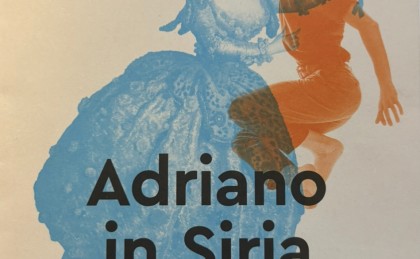In the libretto of Adriano in Siria, Pietro Metastasio provides a perfectly constructed dramaturgy, alternating
brilliant, pathetic, dramatic and sometimes even comical scenes in quick succession. The plot tells the story of
two opposing royal families – the Parthians and the Romans – featuring requited and unrequited love, with
jealousy and sacrifice on the side and the inevitable happy ending, in which the Roman emperor Adriano,
mastering his inopportune passion for the Syrian princess Emirena, reasonably gets back on the track of imperial
decorum and agrees to marry Sabina as originally planned, gives Emirena back to her beloved Farnaspe and
even generously forgives Aquilio for his improper, amorous feelings towards the imperial fiancée. If on one
hand the two lead female roles present a portrait of womanly virtues, such as the ability to change their plans
and opinions, solidarity and faithfulness, on the other hand the male characters rather portray a gallery of
negative behaviours, such as arrogance, stubbornness, weakness, unfaithfulness, insensitivity and excessive
ambition.
I have often wondered what the celebrated Italian dancer Barbara Campanini (1719-1799), known as La
Barberina, who danced at the Potsdam court and established a personal friendship with Frederick II, may have
thought of the characters in the plot when she stood in the wings, waiting for her turn to come on stage and
dance the intermezzi at the end of each act. The story of her life shows how she achieved financial and personal
independence, often challenging received ideals of femininity in behaviour as well as in dance style and
technique, becoming one of the first examples of fully independent women, able to master the course of her
personal and professional life, despite the conventions of marriage, family life or religion. In our staging of
Adriano in Siria, Barberina appears at the end of every act, also travelling through the plot, observing human
nature as Metastasio and Graun portray it in this opera, dancing to newly composed music by Massimiliano
Toni in the form of meditations on the caractères of Baroque dance, with instruments such as ney,
clavicytherium, Mediterranean percussions and recorders. In my choreography, Baroque dance patterns
transform into contemporary forms as Barberina revisits the Potsdam Schlosstheater, meeting the characters as
an unseen, yet observing presence.
The Roman-Syrian historical and geographical context is only evoked in the libretto as a sort of exotic backdrop,
according to the ongoing fashion of Graun’s time; therefore initially I thought the Syrian dimension could – or
even ought to – be ignored. When the scenographer and costume designer Domenico Franchi and I began
working together on this opera, images representing Syria at different periods in history, including nowadays,
compelled me to realise that, unlike the Potsdam court in the mid-18th century, today we no longer stand the
chance – or even have the right – of distancing ourselves and interpreting Syria as a generically faraway land
that we can use as a backdrop.
Our manually operated, painted scenography reflects the conventions of historical opera, allowing different
settings to appear, like the inside and the outside of the imperial castle, the garden and even the fire, blending
naturally with the surrounding architecture and décor of the Potsdam Schlosstheater. Progressively, threedimensional,
true, self-explanatory rubble appear through the polished and painted images of the past, to reveal
a present that we cannot ignore, from where all objects used as props are borrowed: the plot which had begun
in Alessandro’s imperial palace ends in a Syrian refugee camp.
